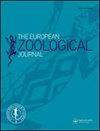Hidden jewels of Malaysia: two new genera and species of remarkable clearwing moths (Lepidoptera: Sesiidae: Osminiini)
IF 1.4
4区 生物学
Q2 ZOOLOGY
引用次数: 2
Abstract
Abstract A stunning scarlet-coloured clearwing moth was found mud-puddling on a rainforest river bank in Malaysia and is described herein as a new genus and species, Scarlata nirvana gen. et sp. Nov.. This sesiid seems to be a rare case of a mimic of an assassin bug (Hemiptera: Reduviidae) in a family otherwise known for hymenopteran mimicry. A high-quality video of the moth’s behaviour in its habitat is provided. Studies of the collections of the Natural History Museum in London revealed another member of the new genus, S. guichardii sp. nov. A third species, S. ignisquamulata Kallies, 2018 comb. nov. is transferred to Scarlata gen. nov. from the genus Aschistophleps Hampson, 1892. The second new lineage from Malaysia described here, Malayomelittia gen. nov., includes two species, Malayomelittia pahangensis Skowron, 2015 comb. nov. and M. ruficrista Rothschild, 1912 comb. nov. Additionally, Heterosphecia bantanakai Arita & Gorbunov, 2000 is placed as a junior synonym of H. hyaloptera Hampson, 1919 syn. nov. Morphological descriptions, remarks on behaviour, conditions of occurrence and a discussion about potential mimicry models are included. All new taxa are figured, including images of male genitalia. https://urn:lsid:zoobank.org:pub:32AF6419-F859-4931-BCA7-848B636CC2EE New genus Scarlata: https://urn:lsid:zoobank.org:act:B8DC2871-DF12-49A9-A7A7-D67E60776E91 New genus Malayomelittia: https://urn:lsid:zoobank.org:act:07B2830B-7E00-4B9D-9D5A-82A7538427F9马来西亚隐藏的珍宝:两新属和两种杰出的清翅蛾(鳞翅目:清翅蛾科:清翅蛾)
在马来西亚的热带雨林河岸上发现了一种令人惊叹的猩红色的清翅蛾,在这里被描述为一个新属和新种,Scarlata nirvana gen. et sp. Nov. 11。这种半翅目昆虫似乎是一种罕见的模仿食虫的昆虫(半翅目:食虫科),在一个以膜翅目模仿而闻名的家族中。提供了蛾在其栖息地的高质量行为视频。对伦敦自然历史博物馆藏品的研究发现了新属的另一个成员,S. guichardii . 11 .第三个物种,S. ignisquamulata Kallies, 2018梳子。十一月被转移到十一月Scarlata gen.十一月从Aschistophleps汉普森属,1892。本文描述的第二个来自马来西亚的新谱系Malayomelittia gen. nov.,包括两个种,Malayomelittia pahangensis Skowron, 2015 comb。11 .和M. ruficrista Rothschild, 1912。11 .此外,Heterosphecia bantanakai Arita & Gorbunov, 2000被列为H. hyaloptera Hampson, 1919同义词。11 .形态学描述、对行为的评论、发生条件和对潜在模仿模型的讨论都包括在内。所有新的分类群都有图形,包括男性生殖器的图像。https://urn:lsid:zoobank.org:pub:32AF6419-F859-4931-BCA7-848B636CC2EE Scarlata新属:https://urn:lsid:zoobank.org:act:B8DC2871-DF12-49A9-A7A7-D67E60776E91 Malayomelittia新属:https://urn:lsid:zoobank.org:act:07B2830B-7E00-4B9D-9D5A-82A7538427F9
本文章由计算机程序翻译,如有差异,请以英文原文为准。
求助全文
约1分钟内获得全文
求助全文
来源期刊

European Zoological Journal
Agricultural and Biological Sciences-Animal Science and Zoology
CiteScore
3.10
自引率
5.60%
发文量
80
审稿时长
30 weeks
期刊介绍:
The European Zoological Journal (previously Italian Journal of Zoology) is an open access journal devoted to the study of all aspects of basic, comparative and applied protozoan and animal biology at molecular, cellular, tissue, organ, organismal, population, and community-ecosystem level. Papers covering multiple levels of organization and integrative approaches to study animal form, function, development, ecology, evolution and systematics are welcome. First established in 1930 under the name of Il Bollettino di Zoologia, the journal now has an international focus, reflected through its global editorial board, and wide author and readership.
 求助内容:
求助内容: 应助结果提醒方式:
应助结果提醒方式:


